Nros 310 exam 3 questions - Study guides, Class notes & Summaries
Looking for the best study guides, study notes and summaries about Nros 310 exam 3 questions? On this page you'll find 12 study documents about Nros 310 exam 3 questions.
All 12 results
Sort by
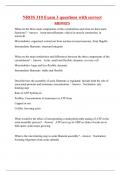
-
NROS 310 Exam 3 questions with correct answers
- Exam (elaborations) • 21 pages • 2023
- Available in package deal
-
- $15.49
- + learn more
NROS 310 Exam 3 questions with correct answers
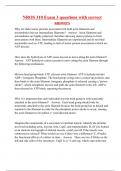
-
NROS 310 Exam 3 questions with correct answers
- Exam (elaborations) • 15 pages • 2023
- Available in package deal
-
- $13.99
- + learn more
Why are there motor proteins associated with both actin filaments and microtubules but not intermediate filaments? - Answer Actin filaments and microtubules are highly polarized, therefore allowing motor proteins to form associations with them. Intermediate filaments are unpolarized and do not bind nucleotides such as ATP, leading to lack of motor protein associations (which are ATP driven). How does the hydrolysis of ATP cause myosin to move along the actin filament? - Answer ATP hydroly...

-
NROS 310 Exam 3 questions with correct answers
- Exam (elaborations) • 21 pages • 2023
- Available in package deal
-
- $12.99
- + learn more
What are the three main components of the cytoskeleton and what are their main functions? - Answer Actin/microfilament: critical in muscle contraction, in microvili Microtubules: organized, extend out from nucleus (except neurons), form flagella Intermediate filaments: structural integrity What are the main similarities and differences between the three components of the cytoskeleton? - Answer Actin: small and flexible, dynamic, in every cell Microtubules: large and less flexible, dyna...
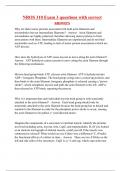
-
NROS 310 Exam 3 questions with correct answers
- Exam (elaborations) • 15 pages • 2023
- Available in package deal
-
- $13.99
- + learn more
Why are there motor proteins associated with both actin filaments and microtubules but not intermediate filaments? - Answer Actin filaments and microtubules are highly polarized, therefore allowing motor proteins to form associations with them. Intermediate filaments are unpolarized and do not bind nucleotides such as ATP, leading to lack of motor protein associations (which are ATP driven). How does the hydrolysis of ATP cause myosin to move along the actin filament? - Answer ATP hydroly...
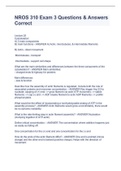
-
NROS 310 Exam 3 Questions & Answers Correct
- Exam (elaborations) • 13 pages • 2023
-
- $14.49
- + learn more
Lecture 25 Cytoskeleton: A) 3 main components B) main functions - ANSWER A) Actin, microtubules, & intermediate filaments B) Actin - direct movement Microtubules - transport Intermediate - support cell shape What are the main similarities and differences between the three components of the cytoskeleton? - ANSWER Main similarities: - charged ends & highway for proteins Main differences: - size & function Describe how the assembly of actin filaments is regulated. Includ...
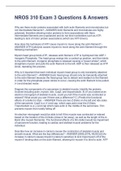
-
NROS 310 Exam 3 Questions & Answers
- Exam (elaborations) • 10 pages • 2023
-
- $12.49
- + learn more
Why are there motor proteins associated with both actin filaments and microtubules but not intermediate filaments? - ANSWER Actin filaments and microtubules are highly polarized, therefore allowing motor proteins to form associations with them. Intermediate filaments are unpolarized and do not bind nucleotides such as ATP, leading to lack of motor protein associations (which are ATP driven). How does the hydrolysis of ATP cause myosin to move along the actin filament? - ANSWER ATP hydrolysis ...
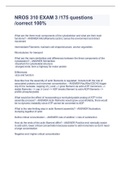
-
NROS 310 EXAM 3 /175 questions /correct 100%
- Exam (elaborations) • 19 pages • 2023
-
- $13.49
- + learn more
What are the three main components of the cytoskeleton and what are their main functions? - ANSWER Microfilaments (actin): sense the environment and direct movement Intermediate Filaments: maintain cell shape/structure, anchor organelles Microtubules: for transport What are the main similarities and differences between the three components of the cytoskeleton? - ANSWER Similarities: -important for cytoskeletal structure -charged ends; form a highway for motor protein Differences: ...
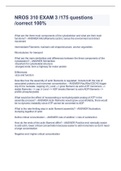
-
NROS 310 EXAM 3 /175 questions /correct 100%
- Exam (elaborations) • 19 pages • 2023
- Available in package deal
-
- $12.49
- + learn more
What are the three main components of the cytoskeleton and what are their main functions? - ANSWER Microfilaments (actin): sense the environment and direct movement Intermediate Filaments: maintain cell shape/structure, anchor organelles Microtubules: for transport What are the main similarities and differences between the three components of the cytoskeleton? - ANSWER Similarities: -important for cytoskeletal structure -charged ends; form a highway for motor protein Differences: ...
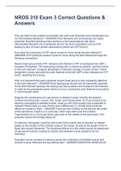
-
NROS 310 Exam 3 Correct Questions & Answers
- Exam (elaborations) • 10 pages • 2023
-
- $10.99
- + learn more
Why are there motor proteins associated with both actin filaments and microtubules but not intermediate filaments? - ANSWER Actin filaments and microtubules are highly polarized, therefore allowing motor proteins to form associations with them. Intermediate filaments are unpolarized and do not bind nucleotides such as ATP, leading to lack of motor protein associations (which are ATP driven). How does the hydrolysis of ATP cause myosin to move along the actin filament? - ANSWER ATP hydrolysis ...

-
NROS 310 Exam 3 Questions & Answers
- Exam (elaborations) • 13 pages • 2023
-
- $11.99
- + learn more
Lecture 25 Cytoskeleton: A) 3 main components B) main functions - ANSWER A) Actin, microtubules, & intermediate filaments B) Actin - direct movement Microtubules - transport Intermediate - support cell shape What are the main similarities and differences between the three components of the cytoskeleton? - ANSWER Main similarities: - charged ends & highway for proteins Main differences: - size & function Describe how the assembly of actin filaments is regulated. Includ...

Did you know that on average a seller on Stuvia earns $82 per month selling study resources? Hmm, hint, hint. Discover all about earning on Stuvia


